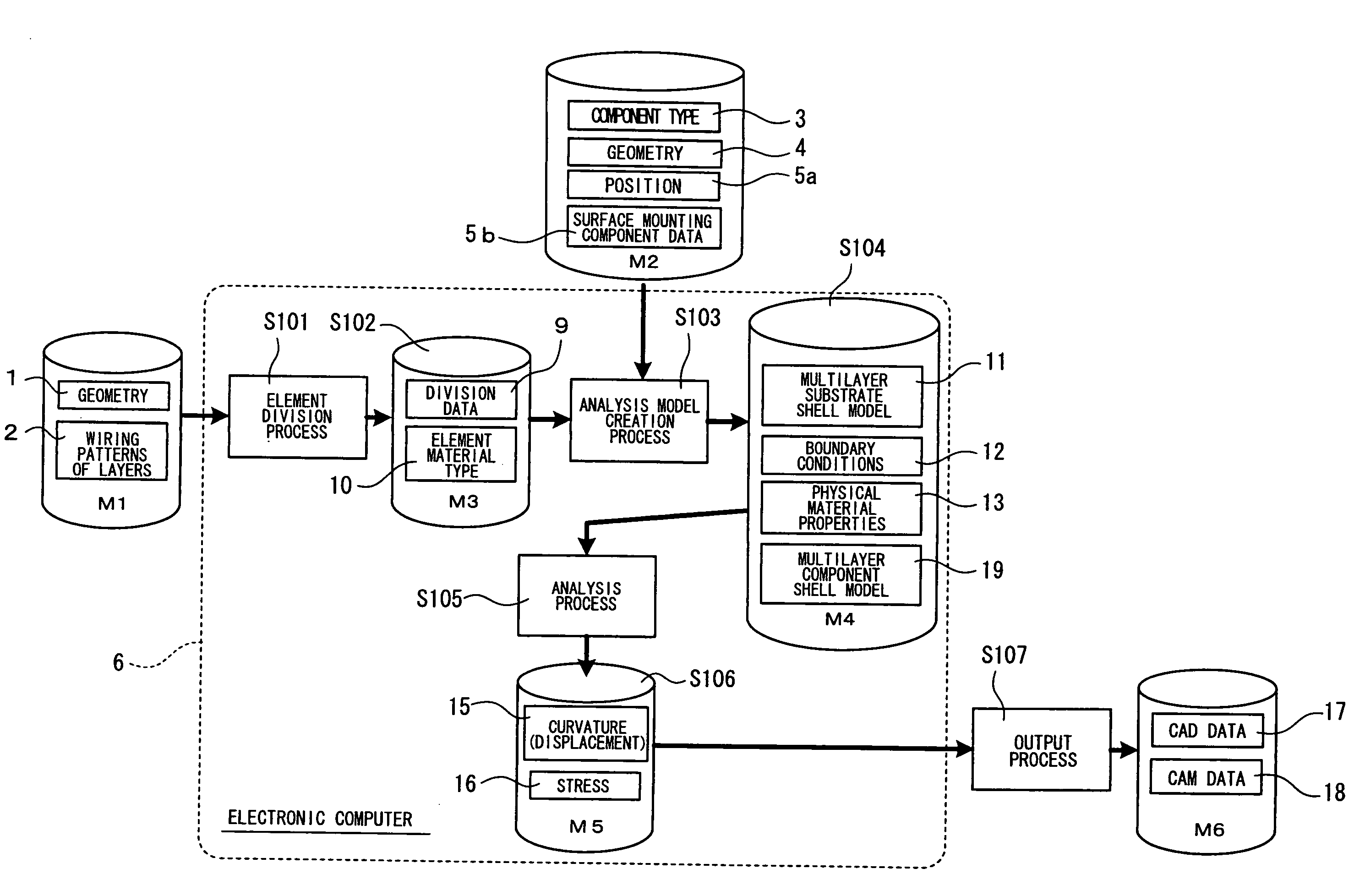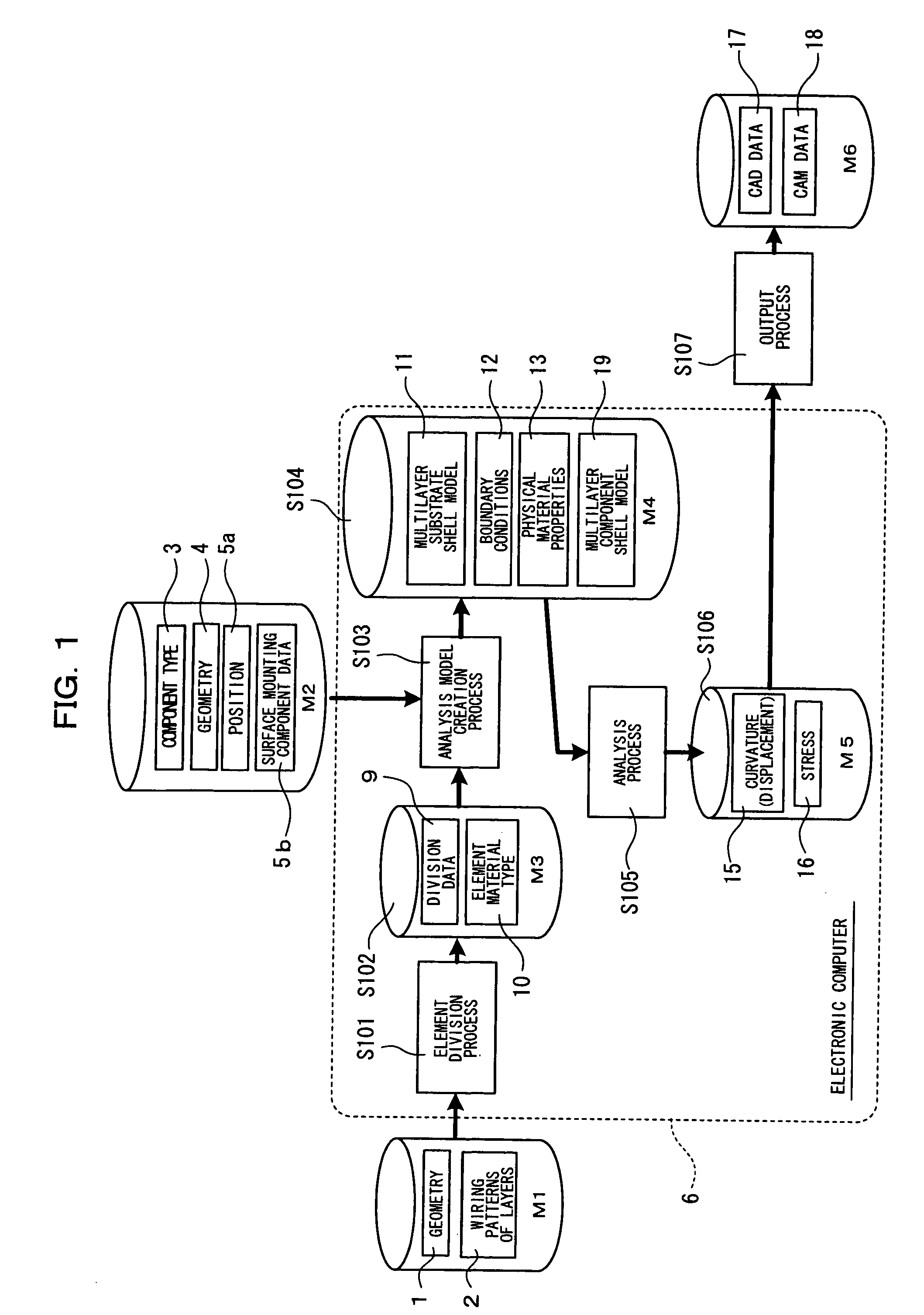Method for Analyzing Component Mounting Board
a technology for component mounting boards and physical properties, applied in error detection/correction, design optimization/simulation, instruments, etc., can solve problems such as malfunctions
- Summary
- Abstract
- Description
- Claims
- Application Information
AI Technical Summary
Benefits of technology
Problems solved by technology
Method used
Image
Examples
embodiment 1
[0052]FIG. 1 shows a flow of stress analysis based on a method for analyzing a component mounting board.
[0053]When processing is initiated, an external geometry 1 of the multilayer wiring board to be analyzed and data 2 of a wiring pattern of each layer are prepared as a first file M1 and a component type 3, a geometry 4 and a position 5a are prepared as a second file M2 when a component is arranged inside the multilayer wiring substrate other than a wiring pattern, via hole, or the like in the multilayer wiring board. In terms of a component mounted to a surface of the multilayer wiring board, surface mounting component data 5b is prepared as the second file M2 for a mounting method, geometry and structure described for each component. In the geometry of the surface mounting component data 5b, data regarding an external geometry of a package and an arrangement of external connection terminals are included in the case of an integrated circuit. In terms of the structure, data regardi...
embodiment 2
[0096]In the element material determination process as shown in FIG. 3(c) in accordance with the above-mentioned embodiment, physical material property values indicating that “the whole portion is the base material 7” and “the whole portion is the copper foil pattern 8” are determined and processed according to a ratio between the base material 7 and the copper foil pattern 8 for one cell in which the base material 7 and the copper foil pattern 8 are mixed. In this embodiment (Embodiment 2), physical material property values are individually determined according to wiring width of the copper foil pattern 8 of each cell, which is different from the above-mentioned embodiment.
[0097]FIG. 12 and FIG. 13 show Embodiment 2.
[0098]FIG. 12 shows a processing routine in which a material of each cell A in the plane of a single layer model as shown in FIG. 13(a) is determined in an automatic process.
[0099]In steps S1˜S11 of FIG. 12, each cell A is scanned in an x-axis direction as shown in FIG....
embodiment 3
[0122]There have been described the embodiments in which a shape and size of a cell of element division are identical in planes of all single layer models. Alternatively, a model scale can be reduced by setting a shape and size of a cell of element division different from other ranges in the plane of a single layer model in which in-plane deformation does not occur or is in a small range.
[0123]That is, an area where the base material 7 and the copper foil pattern 8 are mixed is divided in a smaller size of the cell A as compared with an area occupied by only a material of either the base material 7 or the copper foil pattern 8.
[0124]Specifically, assuming that the remaining copper ratio is read from the data 2 of wiring patterns of the respective layers of the first file M1 with respect to cells roughly divided in advance and the remaining copper ratio of less than or equal to 20% is occupied by the base material 7, the roughly divided cells are not more finely divided. Since it is ...
PUM
 Login to View More
Login to View More Abstract
Description
Claims
Application Information
 Login to View More
Login to View More - R&D
- Intellectual Property
- Life Sciences
- Materials
- Tech Scout
- Unparalleled Data Quality
- Higher Quality Content
- 60% Fewer Hallucinations
Browse by: Latest US Patents, China's latest patents, Technical Efficacy Thesaurus, Application Domain, Technology Topic, Popular Technical Reports.
© 2025 PatSnap. All rights reserved.Legal|Privacy policy|Modern Slavery Act Transparency Statement|Sitemap|About US| Contact US: help@patsnap.com



